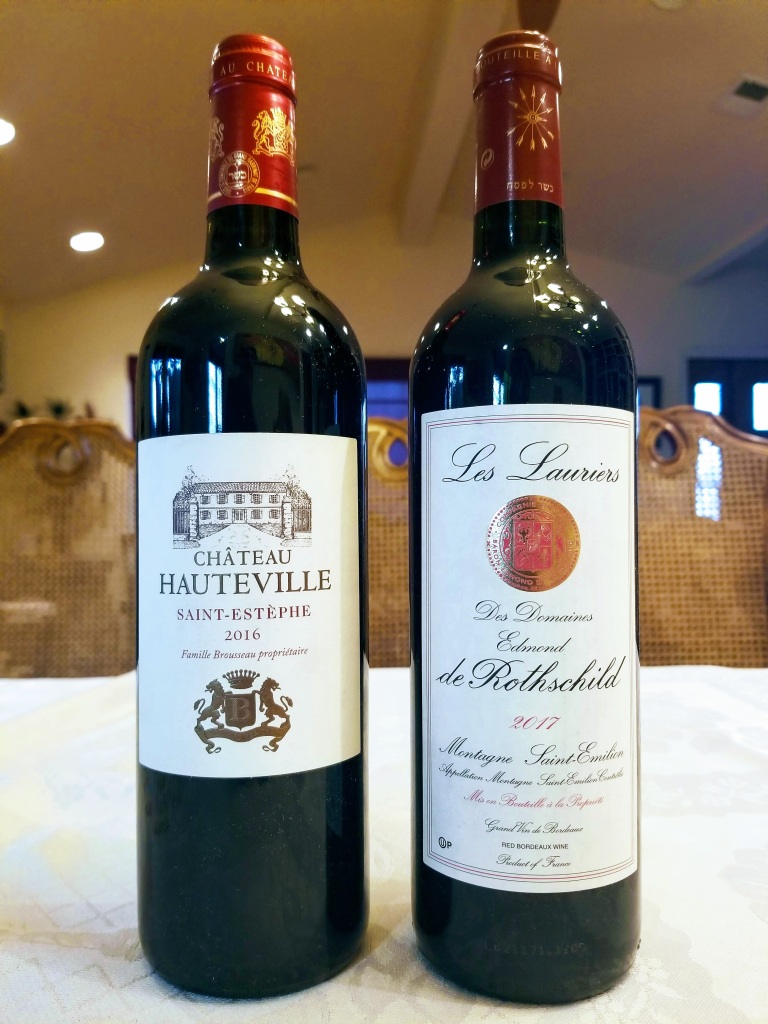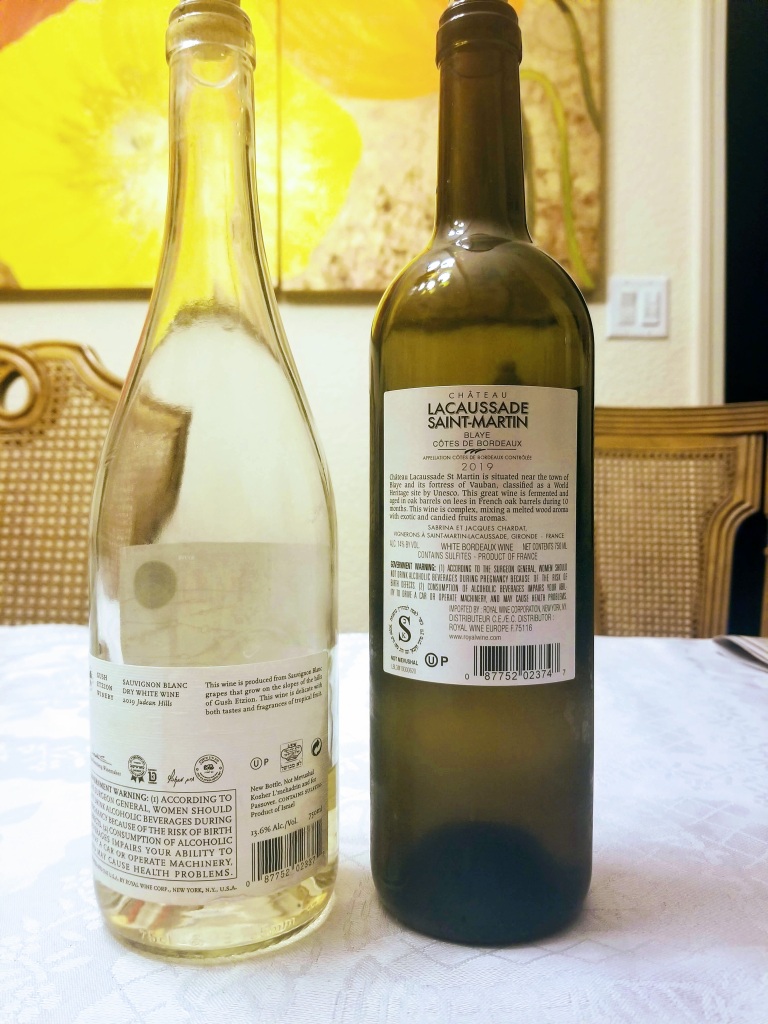Blog Archives
Klal Yisroel is suffering – is wine really that important??
This post comes to me with great trepidation. Not on my behalf but rather I question if I have what to say of the horrors that have befallen a nation that lies so far from many of us. I was called out, by friends, for not posting here after the devastating attacks that were wrought upon the Jewish people in Israel. My reply, then, and maybe still now, is how does wine weigh in on this issue?
So many of my posts here on this blog are counter to the approach new-world wineries have taken to meet the growing needs of the kosher wine-drinking public. The decision was a financial one that was focused far more on what a winery could sell than what it wanted to sell. My words are out there and I do not hide from them. They are my opinions and I stand by them. Still, many take my sharp criticism towards the direction Israeli wineries took to move in an even more new-world direction starting in 2009 as a reflection of my feelings towards the country! That could not be farther from the truth. Israel is the land of our forefathers, it is the land where I first learned to fall in love with wine and it is the land where I traveled to more often than any other location until 2018 or so. In the end, my dearest friends, family, and Rabbis are all in a land that is under attack and I feel deep pain for what my brothers and sisters (literally and metaphorically) have had to endure. The physical and psychological trauma is beyond words. I had the honor to finish the Torah this year at my shul and in respect to that I did a Siyum on Masechet Horayot, a Gemara I finished in the week, along with my Daf and the start of Shtayim Mikrah with Ramban.
My point is that I broke down a few times doing the Siyum, imploring those to do more. More can be like my friends who have flown to Israel to carry food, clothes, and supplies to many on the front or worse. More can be protecting those who cannot protect themselves with funds and so much more. Every one of us cannot be silent we must do more we must stand and state that the atrocities that were wrought upon our nation are not OK. The people are suffering, it is not good enough to ask how people are, it is not enough to wonder if your friends and family are well, it is time for more! Talk to your community leaders and your friends, there are hundreds of opportunities to help those less fortunate than you. Now is not the time to stand on the side it is time to enter into the fray and do more. More is what is being asked of us until those opportunities, calluses, and pain are removed.
So, with all that what does a wine writer have to say to the madness that we watch from afar? Stated simply wine is a business, the very same business that made conscious decisions to meet the needs of the many. That need did not just stop when war was thrust upon a nation. One may think talking about wine is crass and beneath us at a time like this. To that, the simple fact is wineries are real, they need your help, and they need the help of every Jew. We all need to do more. If you enjoy wine, buy Israeli wine. I have a few options here down below. If you dislike wine buy chocolate, buy food, buy Israeli. This is not a question of IF or OR this is an AND. You need to buy AND you need to do more. You need to support Israel as we all must do, and we must buy Israel, and we must pray, and we must learn, and we must do more. This is not the time to shirk your responsibility with IF or OR it is more and it is AND!
I was asked for a list of wines I would buy and do buy and here they are, I have also sprinkled in a few wines that may accommodate other people’s palate. In the end, it is upon all of us to do more, stand by our brothers and sisters, and remember that the lack of action, whether within or external, is tantamount to supporting those who have terrorized our nation. Stand strong, stand well with Israel, and you will be supported as well.
What follows is a smattering of current wines I buy/bought and wines I have tasted recently that you may all enjoy and buy. Some are older than I thought but they are the vintages I bought or enjoyed.
2020 Vitkin Grenache Blanc, Samson – Score: 92.5 (QPR: GREAT)
This wine is a blend of 90% Grenache Blanc and 10% Macabeo. The nose of this wine is lovely, ripe, tart, and elegant, with intense floral notes, violet, yellow flower, orange blossom, orange, minerality, and peach, just lovely! The mouth of this medium-bodied wine is lovely, ripe, balanced, tart, and elegant, with hints of oak, and a lovely almost oily mouthfeel, backed by intense acidity, showing lovely peach, apricot, melon, green tea, and smoke. The finish is long, tart, ripe, and balanced, with great smoke, hay, straw, fruity, and bracingly acidic. Bravo!! Drink until 2025. (tasted August 2023) (in San Jose, CA) (ABV = 13%)
NV Matar Blanc de Noir Brut, Galilee – Score: 92 (QPR: WINNER)
I wanted to ding this wine for the bottle shape, NO this is not cool! It is IMPOSSIBLE to store, and painful to ship, it may look nice, but it is a disaster, and I am sorry, it is a horrible idea. Now, let us get to rating the liquid in this horrible bottle! This wine is slow to open with lovely notes of green apple, Asian pear, peach, pomelo, lovely minerality, yeasty notes, and sweet Meyer lemon. The mouth of this medium-plus-bodied wine is a pure pleasure, it is acidic to the core, it is yeasty, it is nutty, it is clean, with lovely small mousse bubbles refreshing your palate like light butterflies dancing on your tongue, along with slate, slight tannin, beautiful minerality, green apple, Asian pear, peach, tart orange, and sweet quince. Lovely! The finish is forever, with enough weight, just tantalizing, with mineral, slate, saline, and lovely mousse and tannin and acidity that lingers forever with the pomelo and tart orange! Bravo! This harkens back to the early days of Matar, really a joy! Drink until 2027. (tasted September 2023) (in San Jose, CA) (ABV = 12%)
2021 Netofa Matzpen, Galilee – Score: 92 (QPR: WINNER)
This wine is a blend of 33% Grenache, 34% Syrah, & 33% Mourvedre. The nose is ripe, a bit too much for me, candied cherry, candied plum, rosehip, white flowers, smoke, green notes, roasted herbs, and sweet smoking tobacco. The mouth of this medium-plus-bodied wine is nice, with great acidity, and balance, still candied, but that will calm, with cranberry, pomegranate, dark cherry, life-saver candies, raspberry, layers of sweet oak, and nice tannin. The finish is long, tannic, layered, and refreshing, tart enough to make it all work, let’s watch this evolve a bit over the next few days. Drink from 2026 until 2030. (tasted October 2023) (in San Jose, CA) (ABV = 14%)
2019 Netofa Latour, Red, Galilee – Score: 91+ (QPR: WINNER)
Oh WOW! This reminds me of the good old days of the early years of Latour, very nice! This wine is a blend of 70% Syrah and 30% Mourvedre. The nose of this wine is floral, ripe, fruity, bright, smoky, earthy, and dirty, with roasted meat, this is what a Rhone should smell like, wow! The mouth of this full-bodied wine is a crazy WINNER, ripe, balanced, tart, fruity, and dirty, with lovely strawberry, tart, and juicy raspberry, boysenberry, smoke, earth, loam, hints of watermelon, root beer, and lovely garrigue. The finish is long, fruity, tart, smoky, and just fun, with great fruit focus, a dynamite mouthfeel, a very accessible wine out of the bottle, but will last some time as well, lovely!!! Sadly, by the night after opening the wine dulled out, and while it is not bad, and still a WINNER, it is not at the same level as I had upon opening. Right now, I do not truly understand how the wine goes from being a juicy and vibrant wine to being a dull one but such is life. Drink by 2026. (tasted June 2022) (in San Jose, CA) (ABV = 13.5%)
A unique tasting of Kosherwine.com exclusive wines – nice options that range outside of my QPR because of their small production
As always, I am happy to taste wines that are sent to me or that I buy, I do not normally call them out, per se, unless they are at a tasting, like with Royal, IDS, M&M, and others. This is one of those examples, where Kosherwine.com (KW) sent me 24 wines to taste. I have also added some that I bought, exclusive to KW, the Sleight of Hand Cellars, and Doubleback wines. There were also, the Harkham wines that KW started to bring in, I also bought those, but I just have not had the time to taste those yet. I remember well my time in Australia when I was one of the first people to post about the incredible Harkham Azziza Shiraz! WOW! So much fun! Even more enjoyable was hanging out with Richie at the tasting in L.A., I truly hope KW will start to import the Semillon as well soon!
Kosherwine.com’s Exclusive wines
I have spoken about exclusive wines, exclusive wine clubs, and the sort in the past. While I have no issue with them, per se, they do tend to drive up pricing. They do not drive up the price because the exclusive merchant makes a bigger cut, the prices go up because of smaller production and exclusivity.
When you make lots of small wine runs or work with small producers that are OK with exclusivity, it tends to lead to higher prices because of how the product is made. Whether it is wineries in Israel like Shiran, Ghito, Mia Luce, or Sleight of Hand Cellars from Washington State. They are all small wineries with small productions or one-off runs and that leads to higher prices.
In the end, the way I define QPR (Quality to Price Ratio), still revolves around price! So, whether the price is higher because of small production, single runs, or exclusivity, the end goal for QPR is to get a wine that meets the quality and the price of its competitors.
You will see some nice wines below, wines that I would drink, but given the pricing, I could not put the QPR WINNER tag on them. Nonetheless, if you remove the exclusive thing and just stick to the fact that these are a bunch of wines that are nice to well, Israeli reds, the tasting was fun! In the end, that is what matters.
Fun Options
Top Scoring wines
If I was a betting man, and I am not, I would wager that most people will find the Ghito whites to be highly enjoyable. I only had two of them to taste the Uphaz and the Soreqa, but I may well get some other 2021 whites to try.
The Mia Luce white was also quite enjoyable, along with the Yaacov Oryah Chardonnay.
For red wines, the Doublback was quite nice, it had green notes that threw me but overall a very nice wine.
Seven 90 or 90+ scored wines
There were also seven 90 or 90+ scored wines. These included another Ghito white, the Shiran Chardonnay, Mia Luce Syrah, a pair of Domaine Herzberg red blends, along with a Sheldrake sweet wine, and the 2019 Sleight of Hand Cellars Cabernet Sauvignon, Magic.
Closing Thoughts
Overall not a bad lineup of good wines, the prices, as described above keep the QPR scores lower than I would have liked. Still, there are options here for those that want to try new wines, new blends, or unique stories. In the end, KW has done its homework, I hope that as they work on the overall product line, they can maybe also work with their partners to get the prices down.
My sincerest thanks to Dovid Riven for sharing their wonderful wines with me. The wines are listed in the order I tasted them. The wine notes follow below – the explanation of my “scores” can be found here and the explanation for QPR scores can be found here:
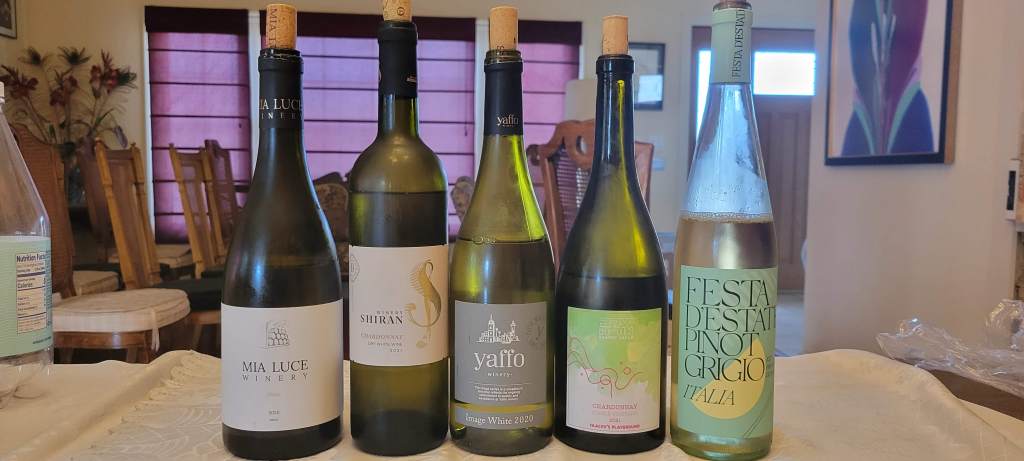
2021 Festa d’Estate Pinot Grigio, Provinicia di Pavia (M) – Score: 87 (QPR: EVEN)
The nose of this wine is correct with green grass, straw, quince, yellow apple, and herbs. The mouth of this medium-bodied wine feels stunted, less vibrant than it should be, the apple is bruised, the pear is browning, the fruit is not crisp, and a bit sweet, and there is good acidity, but it is just not refreshing, with some citrus, and herb. The finish is long, balanced, and with good acidity. Drink now. (tasted March 2023) (in San Jose, CA) (ABV = 12%)
2021 Shiran Winery Chardonnay, Gush Etzion – Score: 90 (QPR: EVEN)
The nose of this wine is the best part of this wine with some muted fruit, not as crisp as I would hope, apple blossom, muddled red apple, muddled pear, and flint. The mouth of this medium-bodied wine feels all over the place, it has acidity but feels hollow in the middle, with red apple, pear, some citrus, and flint. The finish is long, not as refreshing as it should be as the muddled fruit detracts from the overall effect. Drink now. (tasted March 2023) (in San Jose, CA) (ABV = 13%)
2020 Yaffo Image White, Judean Hills – Score: 88 (QPR: EVEN)
The nose of this wine feels muted with more muddled apple and pear, peach, some smoke, and flint. The mouth of this medium-bodied wine is balanced, it feels almost refreshing, with good acidity, but the fruit is where things take a step back, the muddled peach, pear, and apple, are nice enough, but what I want is crisp and refreshingly tart fruit and I feel this is a bit lacking there. The finish is long, balanced, and fruity, with pith, flint, and some smoke. Drink now. (tasted March 2023) (in San Jose, CA) (ABV = 12%)
2020 Mia Luce Blanc, Galilee – Score: 91 (QPR: EVEN)
The 2020 vintage in Israel was tough, this wine has fresh fruit, the issue is there is very little of it, which is shocking for me to say about an Israeli wine! The nose of this wine is fresh and bright with tart green apples, flint, hay, funk, tart pink quince, and peach. The mouth of this medium-plus-bodied wine has a lovely weight, even a bit elegant, with refreshing and fresh fruit, and lovely acidity, I wish there was more fruit, with peach, yellow apple, quince, nice funk, and lovely flint. The finish is long, refreshing, and almost oily, with nice acidity, and some elegance. Drink by 2024. (tasted March 2023) (in San Jose, CA) (ABV = 12%)
2021 Yaacov Oryah Chardonnay, Singe Vineyard, Yaacov’s Playground, Judean Hills – Score: 91(QPR: EVEN)
This wine is a bit closed to start it needs a few hours to fully open up. The nose of this wine is fresh and refreshing with good apple, pear, grapefruit, citrus blossom, a hint of wood, and tart pink quince. The mouth of this medium-bodied wine has lovely acidity, with a lovely mouthfeel, good citrus, quince, lemon/lime, and a nice mouthfeel, crème Fraiche, sweet oak, and nicely refreshing! The finish is long, tart, and refreshing with loads of citrus, oak, and sweet spices lingering long. Drink until 2026. (tasted March 2023) (in San Jose, CA) (ABV = 12%)
More simple white, red, and rose Kosher wines, with some mid-range reds – with more WINNERS
As I close out the QPR posts for each of the wine categories, I forgot a few of the simple white wines – so here is a post of them. Please look at the past simple white wines post for more on QPR and the simple white wine category. Again, QPR (Quality to Price Ratio) is where kosher wine needs to go. QPR means well-priced wines. Still, people do not get QPR. To me, QPR WINNER is what I describe and explain here. The overall revised QPR methodology is described here (and linked from the WINNER post as well).
One more reminder, “Simple” white wines is a wine that will not age more than seven or so years. So, please no hate mail! There are many WINNERS here, enjoy! I also threw in a few roses with one WINNER, but it is a 2019 Rose, and 2020 roses are about to be released, so drink up those 2019 roses already. I also tasted a few reds, with the 2017 Les Lauriers de Rothschild getting a slightly higher score.
The clear WINNER of this tasting is the 2019 Chateau Lacaussade, Vieilles Vignes, Saint-Martin. That along with the 2018 Koenig Riesling, which I like more now than I did a year ago. Also, the 2017 Les Lauriers de Rothschild. The 2017 Les Lauriers de Rothschild, Montagne Saint-Emilion was a winner in my previous post, I just slightly raised the score on it.
The wine note follows below – the explanation of my “scores” can be found here and the explanation for QPR scores can be found here:
ROSE Wines (DRINK them now – if you must)
2019 Rubis Roc Rose – Score: 91 (QPR: WINNER)
This wine is a blend of 50% Cinsault and 50% Cabernet Sauvignon. This is a weighty and food-required style rose than a refreshing rose. The nose of this wine is fresh and alive, with meaty notes, showing red and blue fruit notes, with nice citrus, with good attack and herbs. The mouth on this medium-bodied wine is solid, a drop less acid than I would like, but still very good with hot peppers, green notes, blue fruit, raspberry, dried lime/lemon, with mineral, and nice spice. The finish is long, green, and enjoyable, with good structure and nice minerality, nice! Drink now. (tasted Oct 2020)
2019 Yaacov Oryah Pretty as the Moon Rose– Score: 89+ (QPR: POOR)
This rose is a blend of 45% Syrah, 40% Grenache, and 15% Petite Sirah. The nose on this wine is divine – a lovely nose of floral violet, loads of rosehip, followed by a bit of nice funk, dried and tart cranberry, along with loads of mineral, this smells like what I want from a Provence wine, with dried/tart red fruit, a bit of reductive oxidation, and green notes as well. The mouth on this medium-bodied wine is nice but the acidity is where the wine fails, it has acidity, but the wine’s profile, which has nice fruity and refreshing characteristics lacks the punch of bright acidity to bring it all together, still, showing mineral, and lovely red fruit, with tart strawberry, lovely green/tart apple, quince, watermelon, hints of passion fruit, and loads of mineral. The finish is long, complex enough, with slate, graphite, more flowers, and lovely freshness, WOW! Bravo! Drink now! (tasted Oct 2020)
Kosher Orange wines from California and Israel, QPR WINNERS
I made this a QPR (Quality to Price Ratio) wine category and in many ways I regret it. What I did here was to create a situation where the only competition that exists is the next vintage! Essentially, if you want Orange wine or extended-maceration white wine, you want Yaacov Oryah wines. Not complicated at all. There are a few more out there and they are WINNERS, like the Shirah Orange Wine, and Binyamina Wines made one. Sadly, the Binyamina is sold out here in the USA, but the Shirah is for sale on their site and it is a WINNER! Get some! Kos Yeshuos made one, but in such tiny quantity that it was not for sale. Yaacov Oryah Orange wines are here in the USA and are sold by Andrew Breskin (AKA Liquid Kosher) – check them out!
I have spoken about Orange wine before, mostly when writing about Yaacov Oryah wines. Orange wine is simply the process of leaving white grapes to ferment on their skins, like red wine. To Mr. Oryah it is the truest expression of a white grape varietal and one that Israel can use now to create great white wines, while it searches for more data points on the path for Israel’s white varietals of the future.
The skins add more than just a bit of color, they add a huge amount of natural phenolics, along with tannin (yes tannin in white wine), and then it adds a few extracurricular notes, that some could find challenging. Notes that are defined as nuts and other aspects of reduction or oxidation. The point though is that orange (AKA extended-maceration white) wines are trying to expose more of the white wine than we get from the press and age/bottle style of white wines. Many of the orange wines show the proper and incredible next step beyond white wines we all know. The rich and layered complexity that skins add without some of the extracurricular notes. Some of the wines show those notes and many will find them wonderful, like myself, but in all, it is a show of control, experimentation, and more dots on the plot to a richer future.
When I tasted through the 2019 Yaacov Oryah wines I saw two things that were not as evident in previous vintages. First, the 2019 vintage, for Israel, was HORRIBLE! Yes, I have stated this over and over, but it affected everyone. Second, this was the best showing of a varietal, in regards to Orange wine, then I have ever had. The Viognier, was Viognier, even after the extended -maceration. Same with the Chardonnay and onwards.
Overall, I found the Orange wines to be quite enjoyable. I am posting the 2018 and 2019 vintages of Yaacov Oryah wines, along with the other two Orange wines I had this year. The issue I have revolves around the QPR part of this. There are essentially many Oryah wines and a few others, this is EXACTLY what I was trying to avoid, and now I ran head into it with Orange wines. I stated the logic around the QPR (Quality to Price Ratio) wine categories as trying to find the grouping logic that gave me the largest sample set. Well, I FAILED horribly with this one. Also, the QPR scoring only works for the USA, Oryah wines are imported by Andrew Breskin’s Liquid Kosher. They are of course sold in Israel, but I do not have solid pricing there and that is too complicated. So, yeah, #FAIL, learned from this mistake. Going forward, this category will fall into the Ageable white wines (a post I need to get done as well) and the simple white wines.
PSA: This subject is very debated, but I find that Orange wines show best when cold. The heat on the wines shows as they warm to room temperature, so BEWARE!
The wine notes follow below – the explanation of my “scores” can be found here:
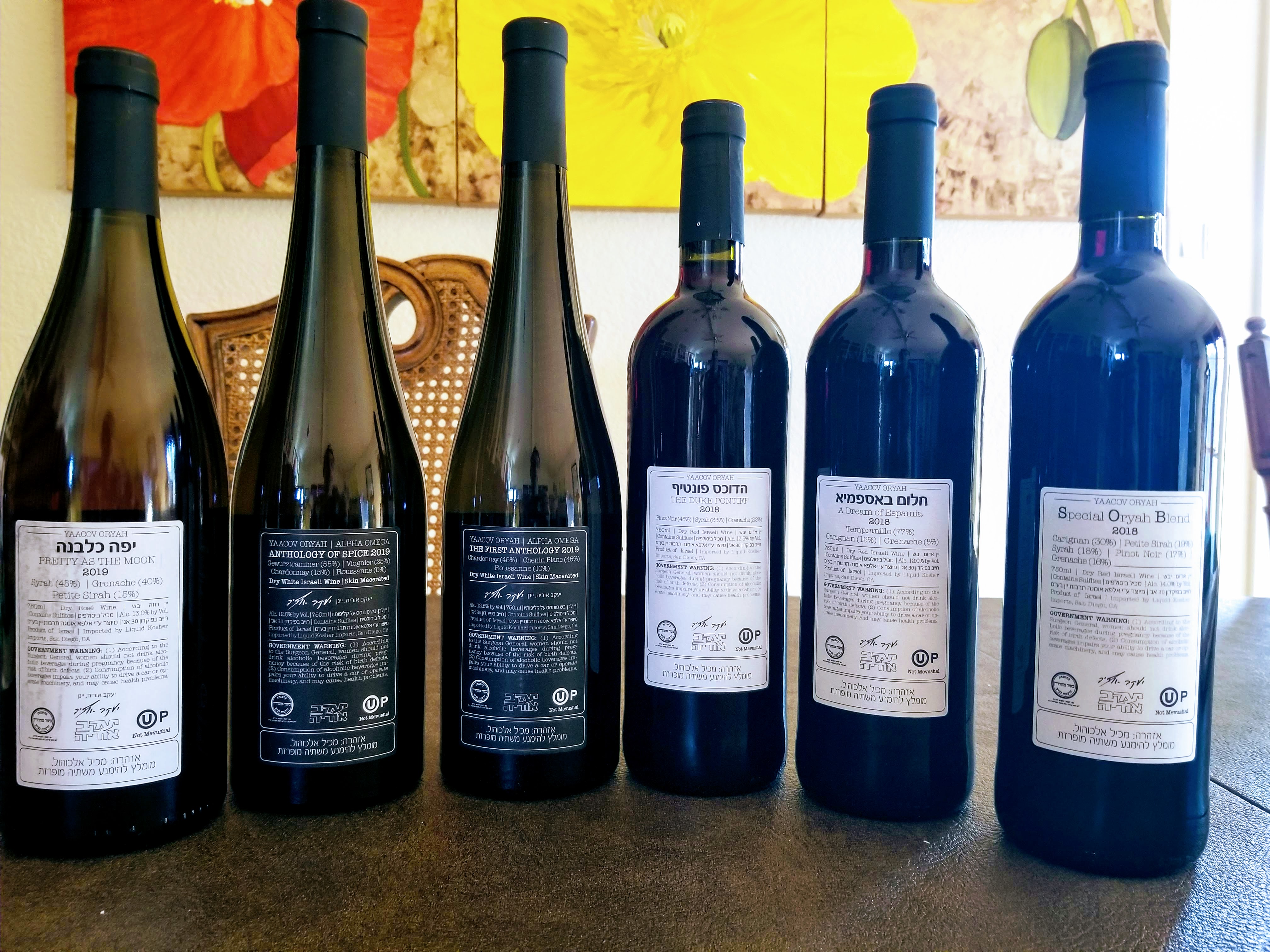
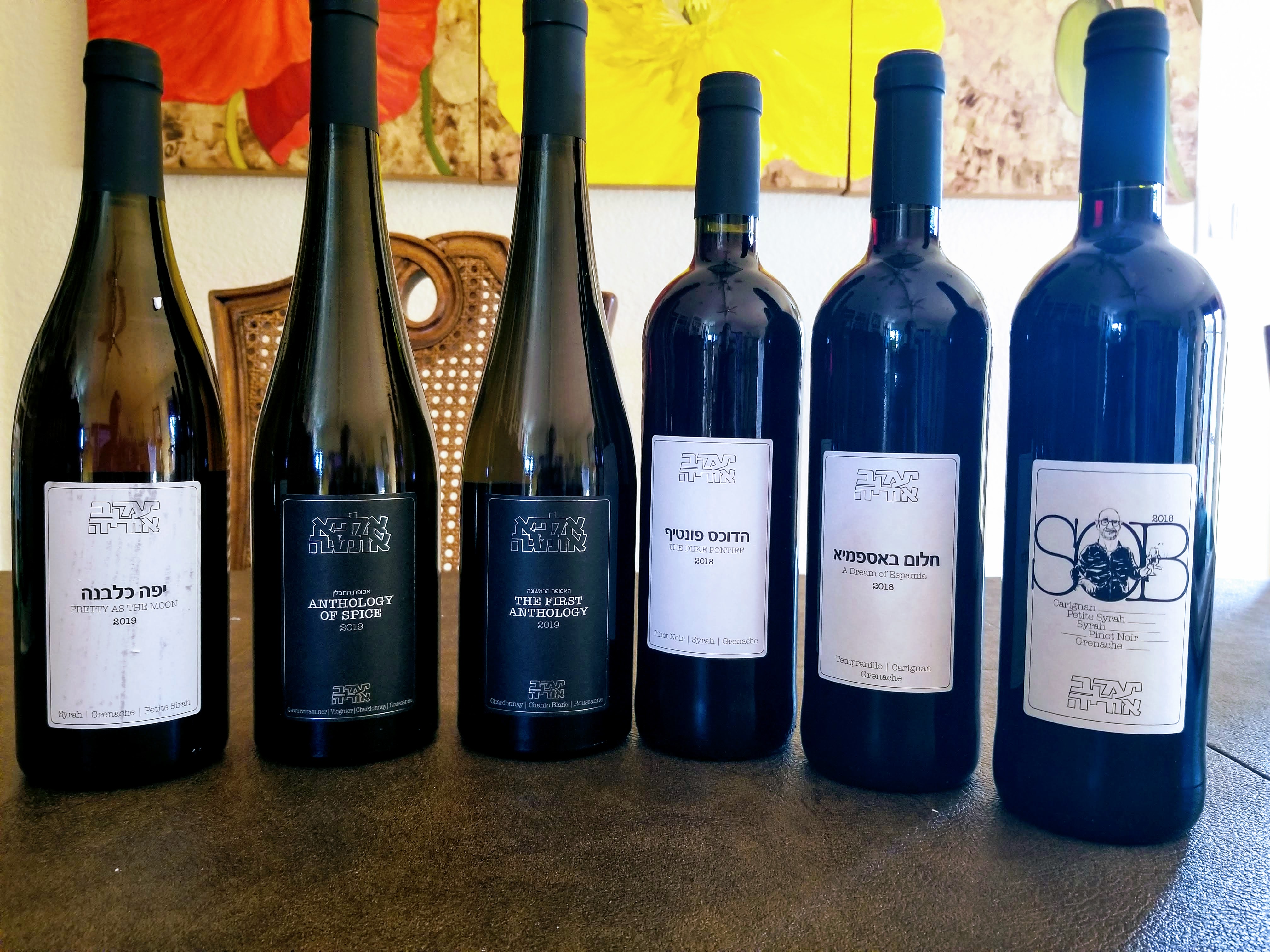
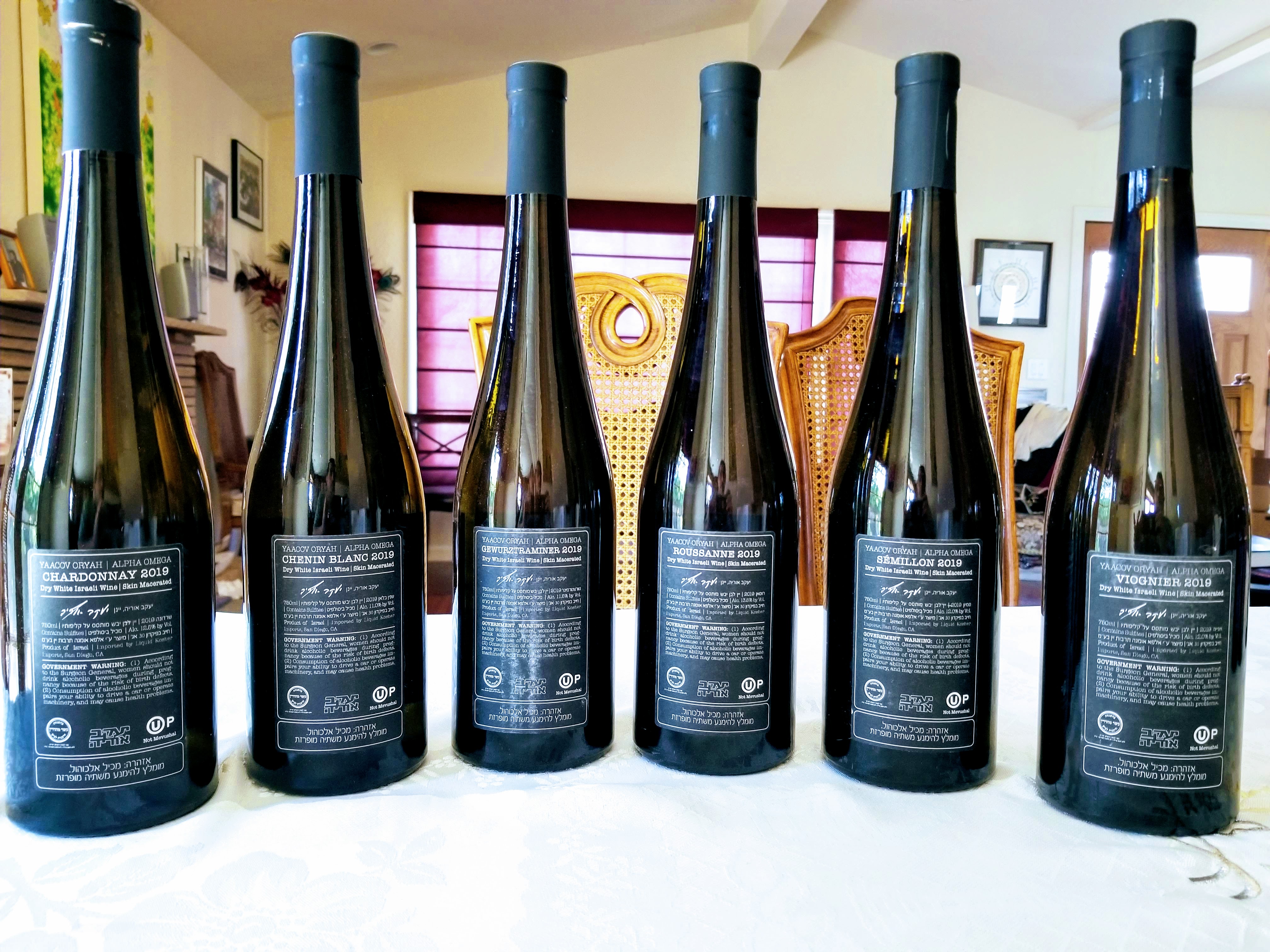
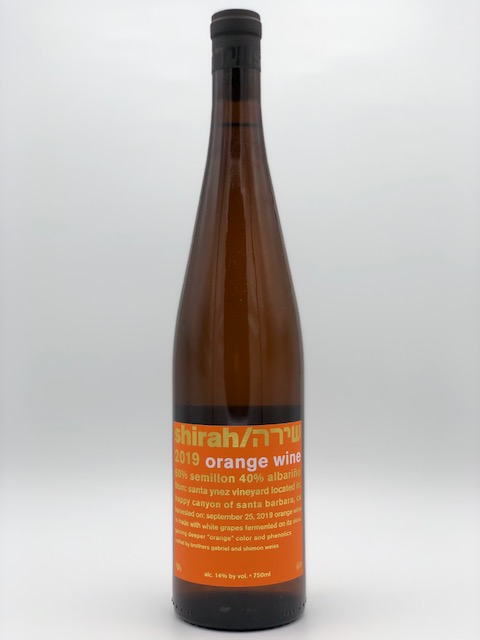
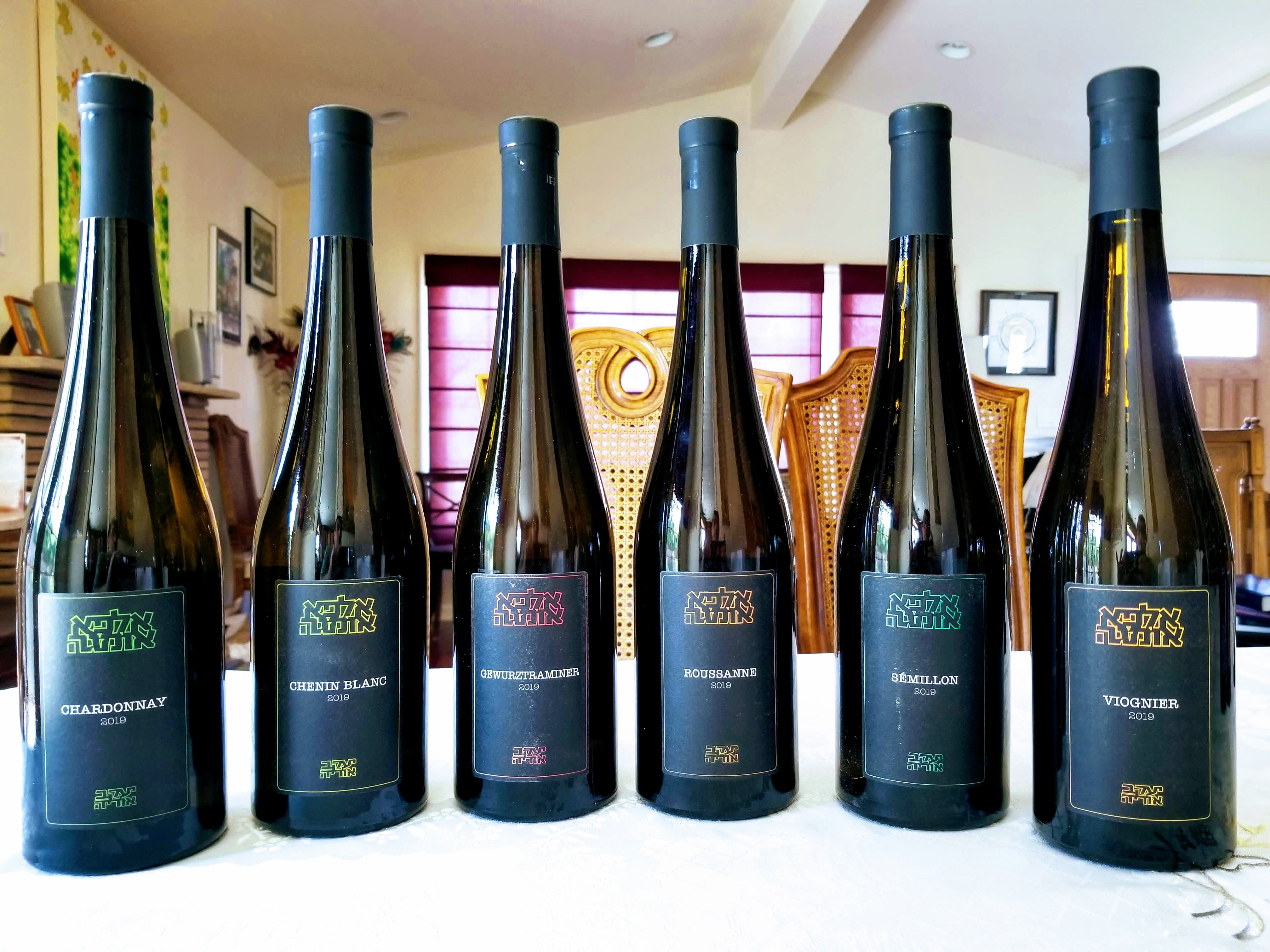
2018 Yaacov Oryah The Anthology of Spice, Alpha Omega – Score: 93 (QPR: WINNER)
This wine is a blend of 50% Gewurztraminer, 40% Chardonnay, and 10% Roussanne. The 50% Gewurztraminer found here is the fruit that I spoke about above, fruit that was going to be wasted for just being itself, heady and spicy. As an Homage of an Homage, yeah more play on play on words, the wine talks to the original AO of old, while also staking this epic spicy fruit to two sturdy partners that add so much, while letting the Gewurtztraminer by itself, without being offensive.
This is not a pineapple juice wine, this wine is more about the Gewurztraminer’s spice, with control, floral notes, blossoms galore, with rosehip, and jasmine-like notes, with apple, and earth. The mouth on this wine is beautifully tannic, great structure, showing a crazy fruit/spiced/mineral structure, with smoke, funk, with crazy layers upon layers of the spices, tannin, with rich extraction, with even more tannin structure than the previous wines, showing spice, nutmeg, cloves, crazy allspice, and floral notes, that give way to roasted herb notes, dry hay, straw, and green/yellow apple lingering long with melon, more grass, lemon, and spice galore lingering long. WOW!! Drink by 2025. (tasted May 2019)
A lineup of the available 2018 kosher Pinot Noirs from around the world
In the past few months, there have been many releases of Pinot Noir from the 2018 vintage. For the most part, there are no real winners here, QPR and otherwise, except for two – the Herzog Pinot Noir, Reserve, and the Herzog Eagle’s Landing Pinot Noir (though the Eagle’s Landing is the only QPR WINNER).
The tasting included all the wines I could find though I left out two, the 2018 Barkan Pinot Noir and the 2018 Tura Pinot Noir. Both of them are Mevushal, and they do a HORRIBLE job on Mevushal, so I did not want to waste my money. My love for all things Pinot is well known, and I had such high hopes. I also seemed to have missed tasting the 2018 Vitkin Pinot Noir, as well.
It is funny how the media can change people’s perspectives, and in some cases twist them in a way that we would not expect. Say Pinot Noir and most wine drinkers will think of the enigmatic anti-hero Miles Raymond, and his explanation on his love for Pinot Noir; “…It’s, uh, it’s thin-skinned, temperamental, ripens early. It’s, you know, it’s not a survivor like Cabernet, which can just grow anywhere and thrive even when it’s neglected. No, Pinot needs constant care and attention. You know?…“. Pinot is a complicated grape – but not to its detriment. Listen to Miles throughout Sideways and you may come to think that Pinot is fleeting, flinty, thin, and complicated. In the end, as you watch that horrible movie, you quickly realize that Miles was simply projecting in a fire fueled rambling and using Pinot Noir as his conduit.
To the French, Pinot Noir is called Burgundy – following the tradition of French wineries to name their wines after the region where the grapes are grown. Americans have had success with Pinot – in California, Oregon, and Washington State. New Zealand, has taken the lead in bringing the grape into the 21st century. The French Burgundy has its terroir (earthy dirt flavors, sometimes barnyard flavors as well). The New Zealand and American Pinots show characteristics that are more akin to Syrah than Burgundy – fruit-forward, meaty wines with soft caressing tannins. The rest of the world is choosing sides. Though true terroir flavors are hard to replicate outside of Burgundy, many countries have been successful at bringing out the true fruit characteristics that the land is willing to share and are creating wonderful Pinot Noirs. Israel was starting to come into its own with Pinot Noir, now all I would buy from Israel, in regards to Pinot would be from Gvaot. Yes, Vitkin does a nice enough job, but Gvaot does a better one. Right now, the best bet is France and the USA, with a drop from Israel, and after that, we are on empty. Sadly, 2018 was not a great year for Four Gates and what I had was not great, it was never officially bottled, but we have 2019 coming soon!
Sadly, Pinot Noir to me is one of those wines that is so badly mangled in the kosher wine world, that it is no shock that most kosher oenophiles, turn face when u say Pinot Noir. Not on account of the Pinot Noir grapes themselves, but rather on account of the pathetic state of kosher Pinot Noir wine on the market.
Say, Pinot Noir to me, and sadly I can only think of:
- Four Gates Winery
- Gvaot Winery
- Eagle’s Landing Pinot Noir (2016 and 2018 are great)
- 2014, 2015, 2017 Chantal Lescure Burgundy from Pommard (I hope there is a 2018 vintage, I disliked 2016)
- 2017 Jean-Philippe Marchand Burgundies (2019 vintage was just released)
- 2018 Jean Luc & Paul Aegerter Burgundies
- 2010 Domaine Gachot-Monot Beaune 1er Cru Les Cent Vignes (this is the last of good “cheap” Burgs)
- 2016 Maison Roy & Fils Shai Pinot Noir, Willamette Valley (Sadly it was a ONE and done deal)
- Hagafen and Vitkin have left me wanting more, and forget the rest of Israel’s Pinot Noirs. The same goes for Pacifica, which has also been lacking, other than one vintage.
Pinot Noir is one of my favorite wines, NO NOT because of sideways! I loved the wine long before that horrific cult movie hit the theaters. I love PN for what it stands for – complexity through things other than fruit! A well made Pinot Noir, in my humble opinion, needs to be of medium body, medium fruit structure, accompanied by mounds of dirt, mushroom, barnyard, and earthy goodness. The ultimate aspect of a great PN is the secondary flavors, not the fruit, not cherry cola, and for the LOVE OF GOD not OAK! It is all about the secondary and old age notes that come with time and love.
Sadly, look at that list. Four Gates is tough to get in quantity. The Gvaot Pinot is available, but they are more Cab and rich than a pure ethereal wine, though very impressive. The Eagle’s Landing 2013 vintage is still available at the winery, and the 2016/2018 vintages rocked! The real winners are the French options, but they are NOT cheap.
So, where are we? Some like the Galil Pinot and other such structured wines, but to me, they are just bad Cabernet in a Pinot’s clothing. This is a shortlist. Heck, there are HUNDREDS of Cabernet, Merlot, Syrah, even many Cabernet Franc options. But say Pinot and numbers dwindle in the blink of an eye. Further, many of the options here are vintage based. For the true Pinot lover, Four Gates and France are your sure bets. Sadly, only the last one is pumping out wines consistently.
PSA: What is wrong with you all?? The Eagle’s Landing Pinot Noir has consistently been a high-rated wine and one that lasts for a very long time, improving along the way with great panache. Yet, you can still buy the 2013 and 2016 vintages of this wonderful wine!! I bought a bunch of 2013 from Herzog. I get NOTHING to tell you this other than pleasure. BUY the wine and enjoy one bottle now and save the others for a rainy day in 2026. Buy this now!!
Sadly, there were no surprises here, the 2018 Gvaot was nice, the Eagle’s Landing was great, and the Herzog Reserve Pinot (a return after many years of non-production) was also very nice. That is about it. The 2018 Jean Luc & Paul Aegerter Burgundies were tasted previously (the notes added here for completeness).
The wine notes follow below – the explanation of my “scores” can be found here:
2018 Herzog Eagle’s Landing Pinot Noir, Santa Rita Hills – Score: 93 (QPR: WINNER)
Let me start by saying buy this wine, buy lots of this wine, I mean a LOT! OK, now this wine is a bigger and richer version of the 2013 Eagle’s Landing Pinot Noir, in other words, this wine is a beast, a winner, and yes – get this wine! My only comment is that this wine is not a classically styled Pinot Noir. This wine is full-bodied and not so much about cherry and raspberry and more about blackberry and spice, I would not have initially guessed this was a Pinot Noir, still this a wonderful wine. My only real complaint is the strangely small cork used as its closure, when the Cabernet Franc has a much longer cork, just not sure why. Anyway, I do not care about corks, as long as they last long enough to meet the drinking window.
The nose on this wine is pure heaven, coffee and chocolate, and fruit madness, with dirt, mushroom, loam, and spice, all wrapped in dark and brooding fruit, showing control, spice, earth, and sheer umami notes, wow!! The mouth on this full-bodied wine is wow! the mouth starts very softly, almost like a leopard crouching before it pounces upon its prey, this wine is beautifully structured to last, and so well made it is almost difficult to get all the thoughts out of my head, layers of fruit, acid, tannin, salinity (that is incredible), black olives, with epic fruit structure and concentration, with clear and bold and jammy blackberry, raspberry, dark cherry, with intense saline, forest floor, searing acidity, and layers of dark jammy brooding but well-controlled fruit. With time the cherry and raspberry fall behind the intense black and intense brooding fruit. The finish is equally impressive with layers of chocolate, coffee, leather, spices, nutmeg, cloves, rich earth, lovely smoking tobacco leaves, sweet and jammy fruit, all wrapped in mineral, spice, and earth. Bravo!!! Drink from 2024 until 2033 or longer.
Latest releases from Andrew Breskin and Liquid Kosher
I have had to travel to San Diego for business this year and thankfully on one of those trips I was able to connect with Andrew and hangout. Mr. Breskin is the founder of Liquid Kosher a wine curator and importer for a wide array of kosher wines, from French wines (like the famous Domaine Rose Camille to Israeli favorites). Andrew invited over a group of wine lovers and made a feast for the eyes and stomach with a wonderful array of food and wines, beautifully presented. It was great to hang with Andrew, which I normally get to do only once a year at KFWE Los Angeles.
Andrew has been the goto guy for access to French wines that are not imported into the United States by Royal or the other larger kosher wine importers. Andrew has brought us Burdungdies like Domaine Chantal Lescure, Domaine d’Ardhuy, along with the famous Domaine Roses Camille, which have been top scorers for many years now.
I had a few of these wines in France last year and they did not show as well as the last two times I have had them here in the USA. Maybe it was a bad wine in France, who knows. I recently tasted the current crop of wines from Liquid kosher and I found them to be lovely wines, which are almost ready now and which will also last for many more years.
One of the most exciting new arrivals into Breskin’s portfolio are the wines from Yaacov Oryah. I am so happy to see them here in the USA, I did not know that Andrew had imported them until he poured a couple of them at the dinner that night. I, of course, placed an order for them that week. Yaacov Oryah’s wines are beyond unique and they are wines that are lovely now but also have time to evolve.
To me, the shocker of the group is the 2015 Clos Lavaud – Lalande de Pomerol. To call a 45 dollar wine a QPR is a bit of a stretch, but to me, it is a no-brainer QPR wine. It is wonderful and a wine that you should stock up on for the price and the quality.
Many thanks to Andrew Breskin and his wife for hosting us and for sharing his time, home, and wines with us. The wine notes follow below – the explanation of my “scores” can be found here:
2014 Chateau Marquisat De Binet, Cuvee Abel – Score: 91
This wine is 100% Merlot. The nose on this wine is black, with loads of vanilla, with black and red fruit notes followed by lovely garrigue, green foliage, with nice mineral, sage, bright cranberry, and a mound of roasted herbs. The mouth on this medium to full-bodied wine is gripping, with mouth-coating/drying tannin, that gives way to screaming acid and lovely blackcurrant, plum, rich blackberry, with loads of tart and juicy raspberry, cranberry, and lovely loam, graphite, all wrapped in an elegant and gripping mouthfeel. The finish is crazy, with more gripping tannin, rich tart and juicy red and black fruit, more lovely green notes, foliage, with mushroom, and herb, with licorice and coffee lingering long. Nice! Drink until 2021.
2014 Echo de Roses Camille, Pomerol – Score: 92
The nose on this wine is not as fruit-forward as what I had last year in France, showing a nose of lovely red and black fruit, mint, and Oregano galore, tar, with forest floor, and earth. The mouth on this medium to full-bodied wine is lovely, showing a mouth that is lovely with core acidity, rich and layered, elegant and expressive fruit, blackberry, cranberry, tart pomegranate, and lovely tart and juicy red fruit of tart cherry, well balanced with freshly tilled loam that is wrapped in a mouth-coating tannin structure and layers of riper fruit that show with time and air, with salinity, more tactile tannin, and loads of mineral. The finish is long, red, green, and filled with mushroom, loam, tilled earth, and forest floor, with tobacco, and milk chocolate. Nice! Drink from 2020 until 2026.
2012 Domaine Roses Camille, Pomerol – Score: 93 to 94
Sheer elegance in a glass, this wine is almost there but still not ready. The nose is rich and earthy, with now loads of mushrooms, followed by red and green fruit, with hints of black in the background, with loads of sweet and ripe fruit, sweet dill, cedar, and rich dirt and deep fruit. The mouth on this full-bodied wine is riper than I would have wished for, but it is beautifully layered with incredibly concentrated dark fruit, with lovely extraction, showing candied strawberry, along with nice dirt, spice, more cedar, and rich layers of green foliage and ripe and juicy cassis, black cherry – that gives way to mineral, pencil, and great focus all underpinned by some nice acid, but I would have loved more acid, the other two wines that I tasted beside the big brother showed more acidity, and more mineral, all wrapped in elegant and mouth-draping tannin that is plush and elegant. The finish is long and green, with sweet notes of juicy and tart fruit, with more great acid, cocoa, tar, charcoal, and tobacco, wrapped in leather and spice. Bravo! Drink from 2020 till 2029. Read the rest of this entry
The 2019 Kosher rose season is open but I am underwhelmed at best
It is not yet summer and here in NorCal, it feels more like winter with these strange May storms with thunder and hail. Sorry, but in NorCal, we do not get thunder, it is very strange indeed! Anyway, enough with my meteorologist fanboy moment, the weather was not conducive for my last tasting here in San Jose with a group of folks, but Rose was on the docket so rose it was.
Rose wine in the non-kosher market is exploding – especially Rose wine from Provence; a wine region of France. Sadly, in the kosher wine market – that is not quite the case. I did not stress my previous statement with a suffix of AT ALL, even though I am not allowed to open a bottle of rose on my Shabbos table with guests – why? Well, that is simple – no one will drink it!!
Even worse, is that wine manufacturers may well have jumped the shark! There will be some 60+ kosher roses available in the USA this year! That may not sound like a lot, but when all you had was Herzog White Zinfandel 10 years ago – it is insane. The first high-end rose was Castel’s 2009 rose and that was only 10 years ago. Back then, there were few to no real Rose wine options, other than a handful of Israeli wines and almost no French Rose made it here. Now we will have tons of Rose, and I really think the real question here is will people drink it all?
Also, I want to bring up a topic I rarely talk about – price! Yeah, I hear you, Avi Davidowitz, of KosherWineUnfiltered, please quiet down, gloating does not suit you – (smiley face inserted here). The prices of Rose wines have gotten out of control. QPR (Quality to Price Ratio) has become nonexistent, essentially here in the USA, for the kosher rose market. Finally, I am sorry, but I really feel that wineries were either horribly hampered in some way with the 2018 rose vintage, or honestly, they just threw in the towel, The 2018 vintage is the worst one in the last 10 years. We have hit Peak Rose, we really have. Peak X is when X becomes so default within the construct of our lives, and the quality and quantity of X peaks. Clearly, calling peak kosher rose is a subjective call, but look around. The roses of 2018 feel commodity at best, they feel rushed, no real care, rhyme, or reason. They feel like we have peaked. They are nowhere near 2017, and 2017 was nowhere near 2016, and so on. I am sure next year may be another peak rose, and to be honest, many have called for Peak Oil and Peak TV, so maybe I am just projecting what I see around me, but this year’s crop of roses feel half-hearted pure cash cows, and really without love behind them.
As always, I will be chastised for my opinions, my pronouncements, and I am fine with that. This is wakeup post, there may be ONE or two roses I would buy, but respectfully, given the prices, I would rather buy, the 2018 Covenant Sauvignon Blanc, 2017 O’dwyers Sauvignon Blanc, the 2018 Goose Bay Sauvignon Blanc, and so on. Throw in the 2018 Tabor Sauvignon Blanc and the 2018 Or Haganuz Amuka Blanc Blend, and really who cares about a rose?
I was thinking about going with the title: 2018 kosher roses, thanks, but who cares? Because that is how I feel. This vintage is a massive letdown, prices are too high, quality has hit rock bottom, and overall professionalism, IMHO, has gone along with the quality. Wineries have been getting away with less and less quality for years, raising prices, and this is the worst I have seen in the rose market overall. So, yeah, who cares?
Wine Color
What is rose wine? Well, simply said, a rose is a wine that can best be defined as the wine world’s chameleon. Where white wine is a pretty simple concept – take white grapes, squeeze them, and you get clear to green colored juice. Yes, the white grape juice is clear – well so is red grape juice, but more on that in a bit. Read the rest of this entry
My recent visit with Yaacov Oryah and the white and orange wine factory
Anyone who has enjoyed an old white wine from Yaacov Oryah’s mind and hands can understand my choice of title. As long as you were not born in this century, of course (OMG, do not bring up the abomination that was the remake).
Yaacov Oryah has had many wineries that he has worked for, made wines for others, and/or consulted with. The official list that I know of is Asif Winery, Midbar Winery, Yaakov Oryah, Ella Valley, and now Psagot, where he is the head winemaker.
For the longest time, as long as I have known the man when we first met at Midar Winery in 2013, I have been struck by his passion, drive, and single-mindedness in creating great white wines in Israel.
Yes, Mr. Oryah can make fine red wines, like the 2011 Yaacov Oryah Iberian Dream, Gran Reserva, and Reserva, the Claro wines he makes for a restaurant called Claro, and others. Still, what I really crave and admire are the white and orange wines.
I have already spoken at length about Mr. Oryah here so I will concentrate on the 2019 releases. Also, if you think that the names of Yaacov Oryah wines are a bit whimsical, then good for you! You are starting to get a glimpse into the operation that is Yaacov Oryah Winery, a blend of whimsical genius, alchemy, great winemaking, and downright unique color all wrapped into a unique lineup of wines that define Mr. Oryah himself.
Orange wine factory
Mr. Oryah keeps saying that the white wines on the market today are a stripped down version of what a white wine should be. Sure, Europe has superstar white wines that can last decades, but that requires unique soil, fruit, terroir, and of course, history. In Israel, where the only thing that really sells well is date juice, that kind of wine is a dream. Still, Mr. Oryah thinks that he can create wines that are still quite unique indeed.
I have had the 2009 Midbar Semillon, and though the tasting in 2016 did not show well, that wine continues to blow me away in tasting after tasting. A Semillon that is 10 years old, and may now finally be reaching its limits. It is not a white wine covered in oak makeup, it is a wine that is pure and truly professional. It is what Mr. Oryah thinks can be done in Israel with white varietals. Yet, each and every year he makes more and more crazy wines. Each one is a data point for a growing list of wines that he sees as potential suitors for the wines he dreams of building.
Until he creates the perfect wine, the wines and data points he is building along the way, are getting better and better. The map and path he is building are not pointing towards another mass produced winery. The data points point towards a more precise and surgically built winery. Where plots or even rows of vines may well define the data point for his dream wine.
Factory of the future
When I heard that Mr. Oryah was creating 10 Orange wines (only 9 are publically available, the other is for a restaurant), four white wines (the varietal Semillon is for a later date), and one rose wine, I thought – I need to taste these!
So, Avi Davidowitz of Kosher Wine Unfiltered, and I made our way to the only real place to taste wine in Jerusalem, the Red and White Wine Bar. Yes, I have spoken about Mark and the bar before. It is still kitty-corner from the beautiful Mamilla hotel (8 Shlomo HaMelech Street at the corner of Yanai Street). Mark is still the ever present and mindful host, and while we tasted through 20+ wines, Mark was there with us through every wine, with food, heady music, with an uncanny ability to feel the room and timing throughout it all. I really feel horrible that I never had the time to go back to the bar and hang with Mark for an evening and watch him ply his trade, teaching the world about the world of Kosher Wine while serving great food and playing really fun music. Hopefully, next time!
I have spoken about orange wines in the past. Orange wine is simply the process of leaving white grapes to ferment on their skins, like red wine. To Mr. Oryah it is the truest expression of a white varietal and one that Israel can use now to create great white wines, while it searches for more data points on the path for Israel’s white varietals of the future. He calls the wine line Alpha Omega (AO) because it is greek for A to Z, to represent that this wine has it all, skin, pulp, and seed, not juice white juice, like most white wines are made.
The skins add more than just a bit of color, they add a huge amount of natural phenolics, along with tannin (yes tannin in white wine), and then it adds a few extracurricular notes, that some could find challenging. Notes that are defined as nuts and other aspects of reduction or oxidation. The point though is that the Alpha Omega line is a showcase of control and experimentation. Many of the wines show the proper and incredible next step beyond white wines we all know. The rich and layered complexity that skins add without some of the extracurricular notes. Some of the wines show those notes and many will find them wonderful, like myself, but in all, it is a show of control, experimentation, and more dots on the plot to a richer future. Read the rest of this entry
Blue Smoke dinner and the London KFWE 2019, posh events in a growing kosher wine and food market
As I said to me old and new found friends in London, I will miss the people, I will miss their kindness and their civility, but they can keep the weather and their inability to drive on the correct side of the road!
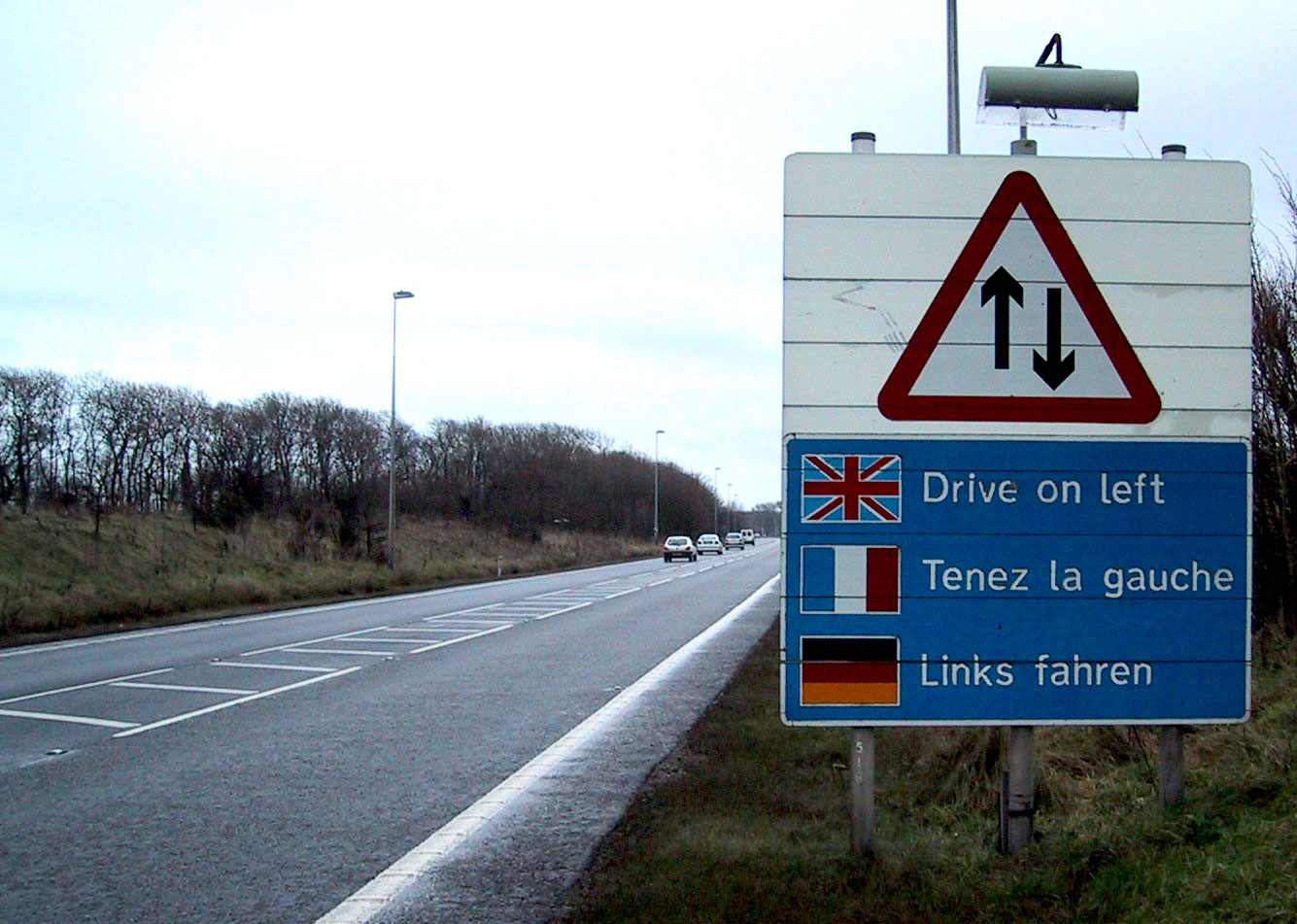
Well anyway, back to wine and food! As stated in my previous post, this was the first year I tried going to more than two KFWE events around the world. I arrived in Paris on Monday, Went to the Bokobsa Sieva tasting, and then on Tuesday, I took the train to London. I arrived in the afternoon and I then got a short rest before heading to a crazy dinner at Andrew Krausz’s house, the master chef of BlueSmoke.
I first met Andrew, and his sidekick, Mordechai, on the hilltop of Four Gates Winery, some 20 months ago! The wines we enjoyed there are listed here. But beyond the wines, one quickly got a sense for the Jewish community of Hendon, London. I must say, I still have nightmares from the dump of a hotel that we stayed at in Golders Green, a large Jewish community kitty-corner to Hendon. Hendon reminds me of everything that is great about London. The people are really nice, the community is tightknit, and they are a bit more aware of the outside world than say Golders Green. That said, I have heard wonderful things about the Golders Green community, I just need to exercise the nightmares of my past. Anyway, enough of my nightmare! The next time you need a nice hotel in Hendon area, Pillar Hotel! Solid, kept up nicely, kosher, and the folks are really nice.
Blue Smoke and Andrew Krausz
Take a quick read of this article to get a sense of Andrew and the work he puts into Blue Smoke and the joy people are getting from it. The dinner at Andrew’s was insane, to say the least, and there were many winemakers there that we would be seeing again the following evening at London’s KFWE! The courses were highlighted by cured more than smoked but streaked with bits of smoke throughout. The dinner started with gravlax and pickled beetroot. The pickled beetroot was straight crack! It was infused for 6 months! I hope this starts to give an understanding to the participants of the level of effort that was made to put this event together. The care and love for the task at hand by Andrew and his family! Yes, the family, were incredible! They have to live with the madness that fed people like me. From what I could tell, they are happy travelers on the road of food madness that is paved by Blue Smoke, but I am sure the 25 or so people invading their home on a weeknight, and the days and weeks of preparations leading up to that day, may not have been a path so easily traveled. Also, please understand that we would see Andrew for a few seconds as he explained the dish and then he disappeared into the same black hole from which he miraculously reappeared from over and over again. That black hole, the cavernous sized kitchen, was packed with humanity and hands coordinated by Andrew to push out 25 dishes over and over again throughout the evening. Read the rest of this entry



